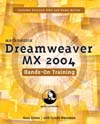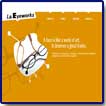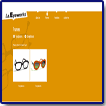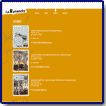Macromedia Dreamweaver
MX 2004 Hands-On Training
"A Great Companion for Web Designers!"

![]()
Title:
Macromedia Dreamweaver
MX 2004 Hands-on Training
Author: Garo
Green with Lynda Weinman
Publisher:
Peachpit Press http://www.peachpit.com
Publication Date:
November 2003
Pages: 690 pages
with CD
ISBN: 0-321-20297-X
Price:
$44.99
Macromedia Dreamweaver MX 2004Hands-On-Training is the latest book in the Hands-On Training series for Dreamweaver MX 2004. It will help you acquire a foundation in: defining sites, links, typography, tables, and so forth. Then you'll move on to fathoming Dreamweaver's precision layout tools, including tracing images, layers, layout cells, and CSS. Included are detailed lessons on rollovers and behaviors, and on Fireworks integration (Dreamweaver itself now contains several basic Fireworks tools, so you won't have to swap programs as often.) Plus it also covers XHTML. The book is filled with insider tips, illustrated with detailed graphics, and accompanied by a CD loaded with classroom-proven exercises and QuickTime movies.
This book is appropriate for both PC and Macintosh users. Check out the Peachpit Press Web site (http://www.peachpit.com) for more information about the book and other books in the Hands-On-Training series. Also check out Lynda Weinman's Web (http://www.lynda.com) site for information on other H.O.T. books and classes.
What I like:
- Step-by-step instruction;
- Screen shots on almost every page;
- Notes, Tips, and charts galore;
- QuickTime movies;
- CD full of extra goodies and demo software.
Dreamweaver MX 2004 Hands-on Training is divided into an introduction, 20 chapters or lessons and an appendix.
Introduction--describes basics about how the book works and background on the authors.
Chapters 1 through 20 cover the following:
- Chapter 1: Background--presents information on: definitions, concepts, and guidelines to help your hands-on Dreamweaver MX training. It includes helpful charts on File-naming conventions; Filename extensions; and DHTML terms.
- Chapter 2: Interface--discusses: the basic concepts of the program's interface. In addition, it also shows you how to set up Dreamweaver MX preferences. This chapter has excellent charts of Document toolbar features; Document window features; and Shortcut keys.
- Chapter 3: Site Control--covers: information on building your Dreamweaver MX site management skills. Very important chapter on the necessity of defining a site in Dreamweaver with a root folder so that Dreamweaver can automatically update your pages when you add, modify, move, or delete files or folders. There is a chart explaining Absolute vs. relative URLs. It includes seven exercises.
- Chapter 4: Basics--presents information on: how to define a site, create and save a page, insert and align images and text, link images and text, define the page properties with CSS or XHTML, and insert meta information (such as keywords and descriptions for search engines). It includes charts on Color picker options and Page properties. It includes eight exercises. See image to the left for a view of the site you will be working on in the book.
- Chapter 5: Linking--helps you learn about: Point to File, which allows you to point to a file inside your Files panel and create the link based on your selection; an email link which is a special type of link that launches your end user's email program and automatically enters a recipient address; named anchors, which work in conjunction with links to allow you to jump to different sections of one page; image maps that are useful fit when you want a single image to contain multiple links; and a final type of link called a file link. File links let you link to files, such as PDFs, SIT and ZIP archives and such. There are no charts but it does have a great section on anchors with screenshots which simplify the process. It includes six exercises.
- Chapter 6: Typography--covers: how to set font styles, font sizes, font colors, and font faces, plus making bulleted lists, definition lists, and unordered lists. Informational charts of Font sizes; HTML text and image alignment options; Ordered, unordered, and definition lists; HTML styles; and using Flash text are included. There are charts on XHTML, HTML default text sizes, HTML text and image alignment options, and Using Flash text. There are seven exercises.
- Chapter 7: Tables--shows you how to: create custom tables, insert rows and columns, come up with color schemes, and handle formatting and sorting tasks. You will also learn how to use tables to align and position images. Useful table tricks: one for creating custom table borders, and another for making rounded table corners. There are charts on Sorting features; and Tabular data settings. It includes ten exercises.
- Chapter 8: Layout--discusses: several techniques that allow you to position elements anywhere on your Web page, such as tracing images and layers, converting layers to tables, and working with layout tables and layout cells. The chapter includes charts on Tracing images, layers, and tables defined; Convert layers to table options; and Layers to tables versus layout view. It includes five exercises.
- Chapter 9: Cascading Style Sheets--provides information on: redefining HTML with style sheets; making classes; using selectors; affecting links with selectors; linking to a style sheet, and creating CSS rollovers. There is are charts on Types of style sheets; and Creating styles in Dreamweaver. There are six exercises.
- Chapter 10: Frames--covers: what are frames; the pros and cons of frames; saving frames; coloring frames; links and targets; adding a background image; background images in frames; and frame objects. It has charts on Love frames; Hate frames; Ways to save frames; XHTML specifications for target names; Frame size settings; and Frame properties in Dreamweaver MX 2004. There are six exercises.
- Chapter 11: Rollovers--describes: creating a simple rollover; creating pointer rollovers; creating multiple-event rollovers; creating Flash buttons; and inserting a navigation bar. There are charts describing: Creating Flash buttons; Adding elements to the navigation bar; and Rollover states. It includes five exercises.
- Chapter 12: XHTML--includes information on: viewing your XHTML; editing in code view; using the quick tag editor; using the tag chooser and tag editor; adding XHTML using a code snippet; cleaning up XHTML; and cleaning up Word HTML. It includes charts on Code view options; and Options in the Clean up XHTML dialog box. It also has seven exercises.
- Chapter 13: Forms--provides information on: working with form objects; laying out a form with tables; and creating a jump menu. There is a chart on Form Objects in Dreamweaver; It has three exercises.
- Chapter 14: Behaviors--presents information on: what is a behavior; setting status bar text; setting text field text; opening a new browser window; validating forms; downloading and installing Dreamweaver MX 2004 extensions. It includes no charts but lots of tips. There are five exercises.
- Chapter 15: Working with Fireworks --describes: external image editor preferences; inserting Fireworks MX 2004 images; editing images with Dreamweaver MX 2004; built-in Fireworks tools; roundtrip editing a Fireworks MX 2004 image; inserting Fireworks MX 2004 rollovers; updating Fireworks MX 2004 XHTML; Fireworks MX 2004 pop-up; and show pop-up menu behavior. There are charts for Dreamweaver MX 2004 to Fireworks MX 2004 Workflow; Built-in editing tools in Dreamweaver MX 2004. It includes eight exercises.
- Chapter 16: Automation--includes information on: the history panel which memorizes and replays steps; and how to create a Web photo album. There are no charts but it has three exercises.
- Chapter 17: Templates/Libraries--discusses: templates in action; creating and modifying templates; library items in action; and creating and modifying library items. There are no charts. It includes six exercises.
- Chapter 18: Accessibility--covers: how to use the accessibility features in Dreamweaver MX to make Web pages. This chapter includes a chart for Input tag accessibility attributes. There are five exercises.
- Chapter 19: Inserting Media Objects --describes: linking to sounds; embedding sounds; inserting Flash content; inserting Director (Shockwave) content; and inserting QuickTime content. There are charts for URLs for downloading plug-ins; Sound formats; and What QuickTime supports. It has five exercises.
- Chapter 20: Getting It Online--describes: how to create a free Web hosting account with Tripod and then use Dreamweaver MX to upload a Web site. In general you learn how to set up your FTP preferences and upload your site to a Web server using Dreamweaver MX. There are charts for FTP information for Tripod; FTP settings in Dreamweaver MX 2004; and Reports dialog box options. It has four exercises.
- Appendix A: A Troubleshooting FAQ: gives you frequently asked questions and answers.
- Appendix B: Online Resources: provides online sources.
For running Dreamweaver MX 2004, you need:
PC:
- 300 MHz Intel Pentium III processor or equivalent;
- Windows 98 SE, Windows 2000, Windows XP, or Windows Server 2003;
- 128 MB of available RAM (256 MB Recommended);
- 275 MB available disk space;
- 1024 x 768 16-bit (thousands of colors) or better.
Macintosh:
- 500 MHz PowerPC G3 processor;
- Mac OS X 10.2.6 or later;
- 128 MB of RAM (256 MB Recommended);
- 275 MB available disk space;
- 1024 x 768 16-bit (thousands of colors) or better.
Web Page Design: Macromedia Dreamweaver MX 2004
| Educational | Books | Utilities | Web Tools | Legal | Articles




